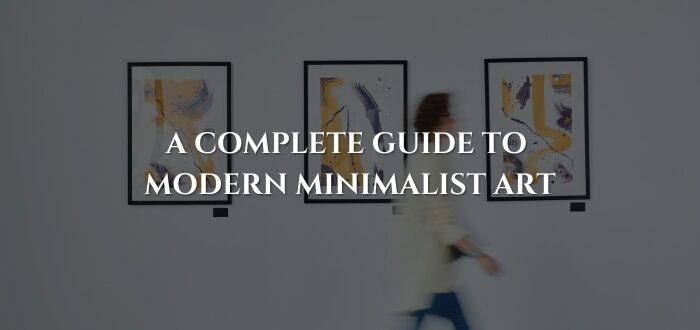A Complete Guide To Modern Minimalist Art
Art has always been a guide to human imagination and subject to interpretation. Modern minimalist art is an emerging trend that shines a spotlight on what truly matters in art. We live in a world of constant noise—notifications, ads, clutter, and overstimulation. That’s why many people are drawn to minimalism, a movement that embraces the philosophy of “less is more.” While minimalism appears across design, fashion, and lifestyle choices, one of the most striking expressions of this movement is found in modern minimalist art.

So, what is minimalism in modern art? While modern art is a style of art marked by a significant departure from traditional styles and values, modern minimalist art strips away the unnecessary to spotlight what matters—form, balance, space, and intention.
Minimalist paintings invite you to slow down, breathe, and appreciate the quiet beauty of simplicity.
In this guide, we will explore modern minimalist art, its defining features, and home decor tips to enhance your space with these paintings.
Also Read: Evolution of Abstract Art
What Is Modern Minimalist Art?
Modern minimalist art finds its roots in the minimalist movement that emerged after the Second World War. The early artists of the minimalism style aimed to strip down art to its base form, removing distractions and focusing on true art to reveal beauty through simplicity. The idea was to make the artwork speak for itself by reducing it to its necessary elements. At its core, minimalist art values clarity, balance, and restraint.
But modern minimalism isn’t just a copy of the 1960s movement. It has evolved. Today’s minimalist art embraces subtle textures, unexpected compositions, and even blends of traditional and digital media. Artists explore how simplicity can coexist with warmth, emotion, and modern living spaces.

Whether found in a gallery, printed as minimalist wall art, or incorporated into home design, it continues to embody the philosophy that less truly is more.
Features of Modern Minimalist Art
If you’re trying to recognize or appreciate minimalist art, here are the key features that define it:
- Simplicity of Form
Shapes are often geometric—squares, circles, lines. The artwork avoids unnecessary decoration.
- Limited Colour Palette
Minimalist paintings often rely on neutral tones like black, white, beige, or gray. Sometimes a single bold colour becomes the focus.
- Use of Negative Space
The space around the artwork (the “empty” areas) is just as important as the subject.
- Clean Lines & Order
Minimalist line art, for example, uses continuous strokes or geometric outlines to create balance.
- Focus on Materials
In sculpture or installations, minimalist artists highlight the raw qualities of steel, glass, wood, or stone rather than disguising them.
- Calm, Meditative Quality
Minimalist art isn’t meant to overwhelm; it creates a sense of calmness and clarity.
Modern vs Traditional Minimalism
Traditional minimalism in art—born in the 1960s—was rooted in strict objectivity. Artists aimed to remove all traces of personal expression, symbolism, and emotion, leaving only pure form, structure, and material. Frank Stella is an example of a famous minimalist artist. The simplicity of Stella’s artwork makes it stand out. By contrast, modern minimalist art retains the same philosophy of restraint but allows greater flexibility and individuality. Contemporary artists often weave in:
- Gentle curves instead of rigid geometry.
- Imperfect lines that reveal a human touch.
- Muted or natural colour palettes inspired by earth, stone, or sky.
- Subtle textures that add warmth and depth.
This evolution makes today’s minimalist works more accessible and emotionally resonant.
Why Minimalist Art Works in Interiors?
Minimalist art resonates strongly in modern home decor because it provides both balance and breathing room. In uncluttered interiors, where every piece has a purpose, minimalist art serves as a grounding element.
Decor Tips With Modern Minimalist Art
One reason minimalist art is so popular is that it fits beautifully into modern home decor. Here are some ways to incorporate it into your space:
- Choose Large Statement Pieces
A large minimalist wall art canvas with bold lines or monochrome tones can anchor a room and set the mood.

- Pair with Neutral Furniture
Minimalist art works best alongside uncluttered, neutral spaces. White walls, wooden floors, and clean-lined furniture let the artwork shine.
- Experiment with Minimalist Line Art Prints
Affordable minimalist art prints featuring one-line drawings are trending and make perfect accents in bedrooms or hallways.
- Mix Texture with Simplicity
Combine minimalist abstract paintings with textured fabrics like linen or wool to create warmth while keeping the minimalist look.
- Use Japanese Minimalist Art for Zen Vibes
Incorporating art inspired by Zen brushwork or Japanese simplicity can create a calming, meditative atmosphere.
- Stick to a Cohesive Colour Palette
If you love black-and-white minimalist art, repeat those tones in your decor. Consistency is key to minimalist design.
- Frames Matter Too
The right frame can make or break the effect of minimalist wall art. To maintain a clean, balanced look, opt for thin wood frames, matte black finishes, or sleek metal frames in gold or silver. These choices enhance the artwork without overpowering it.
Appreciating Modern Minimalist Art
Art appreciation is more than admiring how something looks—it’s about engaging with a work on a deeper level.
- Expose Yourself to the Art
The more minimalist art you experience—in galleries, online exhibitions, or even in interior spaces—the more your eye learns to recognize its nuances.
- Find Personal Meaning
Minimalist art often leaves interpretation open. Instead of searching for a “hidden message,” focus on what the piece stirs in you—calm, clarity, curiosity.
- Slow Down and Observe
Minimalist art isn’t about instant impact. Pause and let the work reveal itself.
- Consider the Philosophy
Minimalism is rooted in ideas of clarity, simplicity, and intentional living.
- Relate It to Daily Life
Minimalist art can be more than decoration; it can influence how you live. Its simplicity can inspire you to declutter, focus on essentials, and embrace calm in your own spaces.
By approaching minimalist art with patience and openness, you’ll find that “less” is never empty—it’s an invitation to slow down, reflect, and discover more.
Also Read: A Guide to Reading Paintings
Why Collect Modern Minimalist Art?
Whether you’re a first-time buyer or an experienced collector, modern minimalist art has a strong appeal:
Timeless Aesthetic: Minimalist pieces never go out of style.
Versatility: Works with almost any decor style—modern, Scandinavian, industrial.
Accessibility: You can find affordable minimalist art prints as well as high-end originals.
Emotional Value: Creates calm, focus, and mindfulness in daily spaces.
Look forward to our upcoming ‘Modern And Contemporary Art’ Auction in August 2025 and pre-register today!

On A Concluding Note:-
Minimalism in art isn’t about what’s missing—it’s about what’s essential. By stripping away distractions, modern minimalist art creates clarity, balance, and a sense of peace.
It’s more than an aesthetic choice. Minimalist art offers space to think, breathe, and feel—qualities that are rare in a cluttered world. Even something as simple as a minimalist poster or print can transform a room, bringing calm energy and quiet focus into your daily environment.






